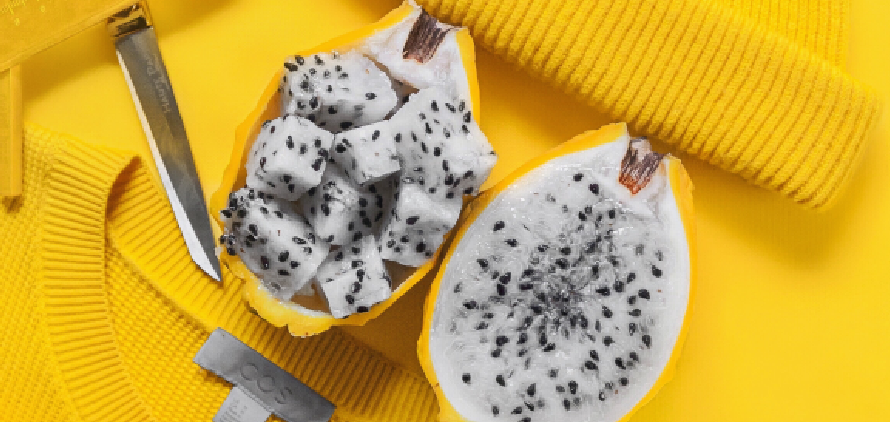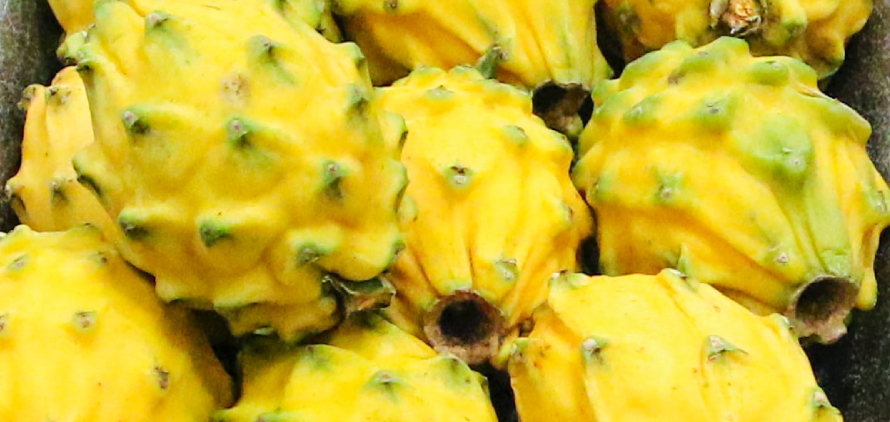When you hear the word “dragon fruit,” what comes to mind?
For most people, it’s a pink fruit with pale white yet dotted inner flesh. The dragon fruit is known for its colorful appearance, as well as its sweet taste, which makes it a perfect ingredient for beverages, sorbets, sherbets, smoothies, juices and even salads.
But did you know that the dragon fruit isn’t just pink? A yellow one exists!
Meet The Yellow Dragon Fruit
The yellow dragon fruit (otherwise known as the yellow pitahaya or yellow pitaya) grows on the Hyolecereus cactus plant, which is often grown in Colombia (the largest producer), Ecuador, Costa Rica, Nicaragua, Panama and Peru. However, it’s not exclusive to South America nor is it a rare fruit. It is also cultivated in tropical and sub-tropical regions like Australia, the Caribbean, Southeast Asia, India and the United States.
In the United States, the yellow dragon fruit is often grown in Florida and California, but on a smaller scale.
As long as there are tropical forests in an area, it is likely you’ll find a yellow dragon fruit. This fruit’s cactus thrives in warmer climates. It is cold-hardy and heat resistant. Also, this yellow version of the pitaya fruit is available all year-round. Its peak availability is during the fall and early summer months.
What’s The Difference Between Yellow and Red and Pink Dragon Fruit?
So, how does the yellow dragon fruit differ from the red and pink dragon fruit? In general, all three types of dragon fruits taste the same, as well as share the same price and nutrient density. The yellow version sets itself apart from the other varieties by the following:
- Taste. The yellow dragon fruit has a sweeter taste and more floral notes.
- Appearance. Apart from its yellow color, the yellow dragon fruit is slightly smaller and has thicker skin.
- Flesh. This yellow variation’s flesh is more grayish white. It also has fewer seeds compared to the other dragon fruits.
How Does The Yellow Dragon Fruit Taste?
As mentioned above, the yellow dragon fruit tastes sweeter compared to the other dragon fruit variations. The flesh is very juicy and succulent with a hint of a tropical and fruity taste. The small black seeds are also crunchier.
Some people prefer the yellow dragon fruit over the red and pink varieties for its lighter taste. When you bite into the flesh of this fruit, you’ll immediately be rewarded with a rush of sweetness and floral juice.

The Preparation Part: How to Cut the Dragon Fruit
Before you indulge in your yellow dragon fruit, it’s best to clean it first. A good rinse removes all the dirt. Next, get a sharp knife and cut the fruit in half lengthwise. If you want to cut it horizontally, you can do so but a lengthwise cut maximizes all the flesh of the yellow dragon fruit.
Once you’ve opened your fruit, take a spoon and start scooping out the flesh. Do the same to the other half. You have the option to reserve the skin for decoration or serving purposes. Once you have the flesh, chop it into chunks.
One yellow dragon fruit can yield two cups of cut fruit. You can serve them immediately or store them in the fridge. Many people prefer the taste of chilled dragon fruit. If you want to store it in the fridge, store it in an airtight container to maintain the taste and texture.
What Are The Health Benefits of the Yellow Dragon Fruit?
A cup of yellow dragon fruit cubes (six ounces) has the following nutritional content:
- Calories. 102
- Carbohydrates. 22 grams.
- Protein. 2 grams.
- Sugar. 13 grams.
In terms of health benefits, the yellow dragon fruit promises the following:
- Formation of red blood cells. This yellow fruit is rich in iron, which helps in the production of your red blood cells. This is helpful, especially for people with anemia. Pregnant women can also benefit from regularly snacking on yellow dragon fruit since nutrients and oxygen are carried by red blood cells, which nourish the fetus in the womb.
- Body detoxification. The yellow dragon fruit is high in dietary fiber, which improves your digestive system by eliminating the toxins in your body. It also keeps you at optimal health by detoxifying your liver and lightening the workload of the other organs.
- Strengthening of the immune system. This fruit is also an excellent source of antioxidants, which reduces cell damage. Reduced levels of cell damage also reduce your risks for cancer and other health problems. It also reduces your risk for damage due to free radicals, which protects you from premature age-related illnesses. Yellow dragon fruits contain three times more Vitamin C content compared to carrots. Vitamin C helps the body remove contaminants, which enables the body’s cells to heal.
- Lower levels of inflammation. The seeds of the yellow dragon fruit are rich in Omega 3-fats, which help the organs fight against bacterial and fungal infections and other autoimmune diseases. The yellow dragon fruit’s anti-fungal and bacterial properties increase your levels of white blood cells, which protect your body against harmful toxins.
Tips on Buying and Storing Yellow Dragon Fruit
When shopping for yellow dragon fruit, look for the brightly-colored skin ones. Also, consider the texture. Apply a bit of pressure to make sure it’s just as juicy as a pear. If a yellow dragon fruit’s exterior has a few blemishes, best not to buy it. It could be a sign of spoilage.
A fresh piece of yellow dragon fruit has a grayish-white transparent appearance. You may see tinges of brown and yellow but that’s OK.
As for the storage, you can store your dragon fruits at room temperature or in the fridge for a day or two before consumption. As mentioned above, some people prefer to eat chilled dragon fruit.

The Bottom Line
Dragon fruit is a low-calorie snack available in three different variants. The yellow dragon fruit is the sweeter option that offers the same health benefits as its siblings. So, if you’re craving dragon fruit but want something different, enjoy eating this yellow fruit.


